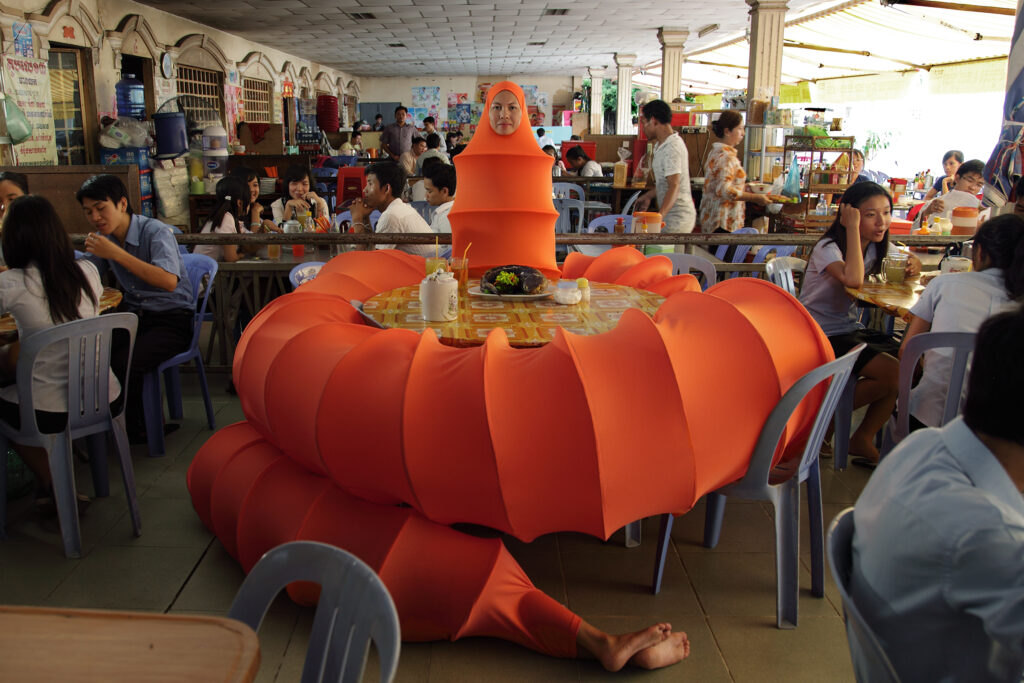By Kai Curry
NORTHWEST ASIAN WEEKLY

A portrait of Anida Yoeu Ali amidst the “Hybrid Skin, Mythical Presence” installation at Seattle Asian Art Museum (Photo by Alborz Kamalizad)
Tacoma-based international artist Anida Yoeu Ali “activated” her acclaimed work, “The Buddhist Bug,” at Seattle Asian Art Museum on March 23. Currently displayed inside the museum as part of Ali’s solo show, “Hybrid Skin, Mythical Presence,” the Bug is 100 meters long and represents both Ali’s “diasporic identity” and “her spiritual turmoil between Islam and Buddhism,” according to the museum’s event page. A striking orange color, the same as what Buddhist monks wear, Ali does not consider the Bug to be “activated” until worn in performance, something she has done countless times around the world.
Ali, who travels frequently to Cambodia, where she was born, said at a press preview, “It took me leaving the United States, to fully realize the work…and to fully come into…performance installation. This idea that I could bring my love of fashion, of textiles, and of…the actual live body, and performance” was something that required her to see both sides of the equation—both sides of her identity. While living in Cambodia from 2011 until 2015, Ali gained a new understanding of what it meant to be Cambodian American and Muslim.
“Something happened upon that return, being in my parents’ homeland, and being amongst the people of Cambodia…amongst the aliveness of this complex society, that would lead to finally actualizing the work that I feel I dreamt of and was meant to create,” she said.

Installation view of “Anida Yoeu Ali: Hybrid Skin, Mythical Presence,” 2024 (Photo by L. Fried)
In addition to the Bug itself, the “Hybrid Skin, Mythical Presence” exhibition contains the “full Bug collection,” which has never been brought together into one show before: 22 photographic images (“not documentation…they aren’t just artifacts; they are works of art in and of themselves,” said Ali)…five original haiku by Ali; four short videos related to the Bug; a large scale corner projection of the Bug at night, commissioned at the Asia Pacific Triennial 8; and a sculpture in the form of an Islamic eight-point star. Included is a list of “Bug sightings”—places where the Bug had live encounters in 10 countries and 13 cities.
The Bug is a curious phenomenon. Ali has witnessed its magic many times. Prior to performing the Bug, Ali and her team will do thorough recognizance of the selected site. It could be an ancient Cambodian temple, a busy street, a school cafeteria, or a museum. Upon arrival at the site, Ali will climb into the top of the Bug—right in front of everyone—while someone else climbs into the bottom to represent the feet (the top includes a Muslim head cover). Even though everyone present has just watched this “inanimate” object become inhabited by two people, and then become “animate,” there is still a convincing transformation that occurs.
“They see me sculpting it…they see me from before being the Bug to being the Bug and then, like clockwork, the magic happens, the suspension of disbelief and they’re in the world of the Bug,” said Ali. “The bug does that. You know she’s not real but you start to question what you’re seeing and whether she is real or not—or surreal perhaps.” With the Bug, Ali challenges viewers to think about the many layers of the subject matter, from the nature of reality to identity to belonging to spirituality. The idea for the Bug arose in large part because once she returned to Cambodia, Ali became aware of, as a Cham Muslim, being a minority, seemingly surrounded by Buddhists.
“this place is a home
unknown, yet familiar still
displaced is a home”
“orange/tangerine
both a bridge and a tunnel
across and over”
“my reinvention
from the past before the last
breath is turmoil”
These three haikus by Ali are on one of the orange walls of the exhibition.

“Campus Dining, The Buddhist Bug Series,” 2012, Anida Yoeu Ali. Image courtesy of the artist, © Studio Revolt. (Photo by Masahiro Sugano)
The Buddhist Bug probably would not have happened if Ali had not returned to her homeland. “That required being there, in the land, amongst the population, where Buddhism is ever present. I don’t know if you would have seen The Buddhist Bug take on the life that it did [without my] being in Cambodia.” Ali is busy as an activist in several areas who explores what it means to be part of a diaspora and to have multiple identities. She is co-founder of Studio Revolt, an artist-run media lab which seeks to disrupt the status quo or the powers-that-be. Her work has been exhibited at the Palais de Tokyo, the Smithsonian, and the Shangri La Museum of Islamic Art, Culture & Design, to name a few. She received her Master of Fine Arts from the School of the Art Institute in Chicago, where she grew up after her family immigrated to the United States.
The event opened with a blessing ceremony and dancers from the Khmer Language Arts & Culture Academy, as well as Wat Changtarangsey Pagoda monks.
Kai can be reached at info@nwasianweekly.com.



